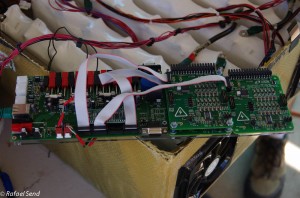Of the two nights we spent in Port Augusta, we worked through most of both. The day we arrived, we had had a team meeting and decided that we would attempt to adopt what we were calling the “new” electrical system in place of the one we had used throughout most of the summer.
A lot of people may not know what this means, so let’s take a step back.

As we started to test over the summer, we discovered various issues with the old system that initially prevented the car from running consistently. Through a series of tweaks and hacks (like the installation of what we call the CAN Bridge, used for forward data from one subset of the system to another) we were able to get a well running car. However, it was obvious that even though this was a probably useable solution for WSC, it was far from ideal. Several of our members began designing proper replacements for the components with issues, but by the time we had actually finished the designs and fabricated new PCBs (Printed Circuit Boards), Impulse had already been shipped to Australia. As a result, we had to bring untested designs with us in our luggage, in the hope that we could install and get them to work sometime before the race.Fast forward to today in Port Augusta.

The most critical of the new designs was a combination of the battery protection system and safety shutdown systems. Previously, they had been two seperate PCBs, but we found that the connecting cable between them suffered from vibration issues, leading to intermittent shutdowns of the entire car. Replacing the old setup required rebuilding the battery box and rewiring most of the car, which took the better part of the two days we had in Port Augusta.The changes involved moving most of our connetions from either DB9 or screw terminals to Minifit Jr (for signals) and Anderson Powerpole connectors (for power distribution). Both of these types are locking connectors, which we believe will solve most of our vibration problems. In addition, a lot of the wiring that previously connected the two aforementioned systems was either eliminated by the combined PCB or moved into the battery box where they do not interfere with the driver or the rest of the car’s functionality.

Ankur, Brian, Lily and myself spent the days making cables, laying out the new battery box and connecting components together. At the end of the second day, Ryan loaded the code that he had prepared for the new system and began debugging. Luckily, there was not much amiss with either his software or our new battery box besides one or two careless mistakes (We had connected a polarized relay backwards and Ryan had a few incorrect constants). After about an hour, we were able to run the precharge and startup sequences successfully, which is a huge step forward and an enormous milestone for CalSol in Australia.The next step is to attach and code the new dashboard, which will happen over the next few days. We’ll keep you posted!
Rafael Send
